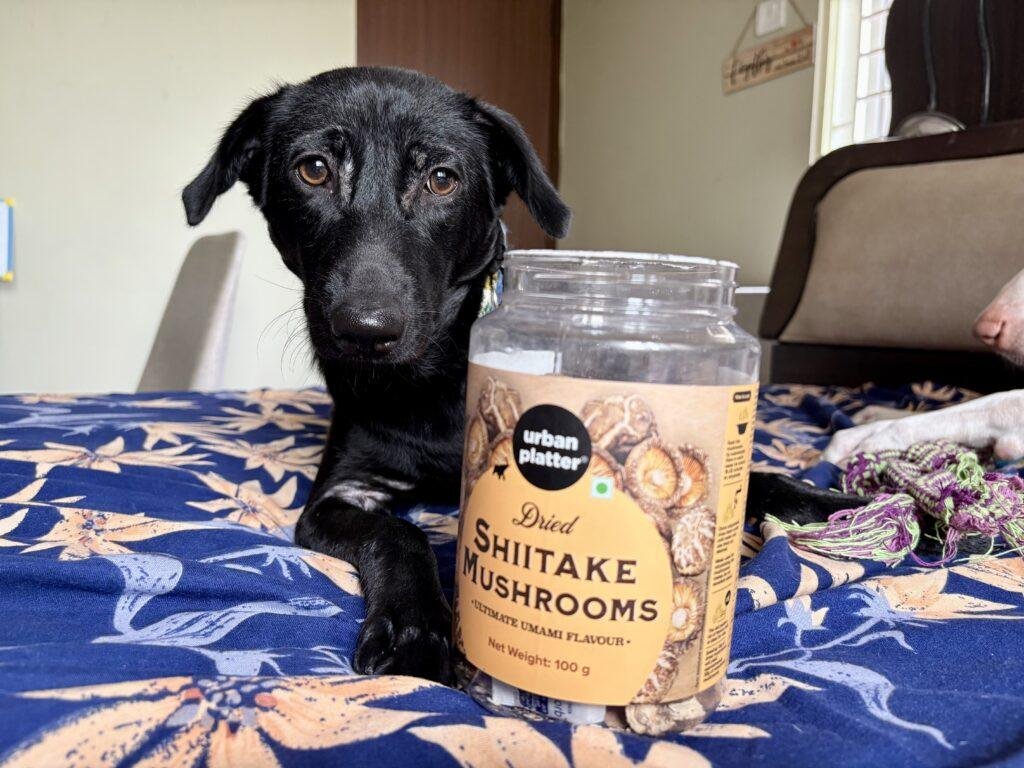
Joint problems in dogs often creep up slowly, in little ways we may not notice at first. The first time I noticed my Rottweiler experiencing joint pain was when he slightly limped after a nap. Then there was a bit of hesitation before climbing the stairs. Very soon, playtimes weren’t voluntary, and he frequently whined or yelped during fetch.
While these small signs can be easy to brush off, they can quietly affect your dog’s comfort, mobility, and overall quality of life over time.
The good news is, joint problems in dogs are manageable. With early detection (like in my Rottweiler’s case), the right care, and a few simple changes in daily routine, most dogs can stay active and pain-free for years.
In this guide, I’ll take you through what really causes joint problems in dogs, the early signs to look out for, practical ways to prevent them, vet-recommended care, and joint supplements for dogs. I’ve also included answers to some of the most common questions dog parents in India have about joint health, so you know exactly when to act and how to support your pup better.
Let’s begin!
Understanding Dog Joint Health As A Pet Parent
What Causes Joint Pain In Dogs?
Joint pain in dogs doesn’t usually happen overnight. Often, it’s a gradual process. However, understanding the root causes can help you catch joint problems early so you can take steps to slow or prevent the damage.
Here are the main reasons joint pain develops in dogs:
Age-related wear-and-tear: As dogs get older, the cartilage (connective tissue that protects joints) wears down. This can lead to osteoarthritis in dogs, where the joint degenerates or wears off over time and cannot naturally repair itself. Hence, what once worked fine before becomes gradually less effective at absorbing impact, and that leads to inflammation and pain.
Genetic predisposition to joint diseases: Some dog breeds are more likely to develop joint issues due to their anatomy or inherited traits. Big breeds (such as the Rottweilers, German Shepherds, Golden Retrievers), or dogs with structural conformations (like shallow hip sockets) are more vulnerable to joint issues like hip dysplasia.
Injury or trauma: A fall, sprain, or repetitive stress from overactivity can injure a dog’s joint or its supporting structures (ligaments, tendons, cartilage). Sometimes, a past injury can leave the joint vulnerable, thus accelerating wear later.
Excess weight gain or obesity in dogs: This is a common issue in many Indian homes, where carb-rich diets for dogs lead to unwanted weight gain. Carrying extra weight can put more stress on joints, especially the hips and knees. Even a few extra kilos can increase the risk of joint problems in dogs over time.
What Are The Common Joint Diseases In Dogs?
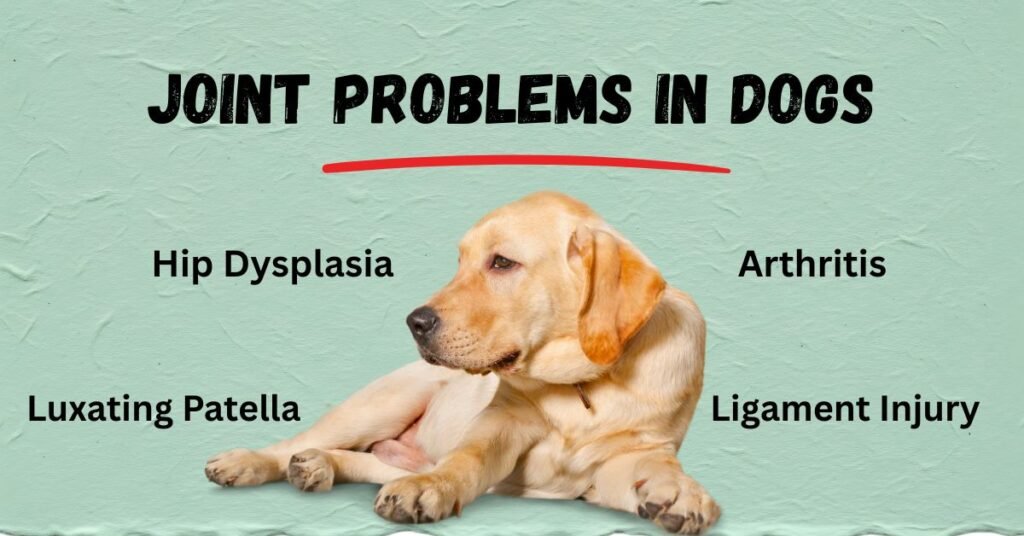
Arthritis
A degenerative joint disease in dogs where cartilage wears down over time, causing stiffness and pain. This is common in older dogs and large breeds.
Hip Dysplasia
It is a condition where the hip joint doesn’t fit properly, leading to friction, pain, and eventually arthritis. It is commonly seen in large or fast-growing dogs.
Luxating Patella
Sometimes a dog’s kneecap can slip out of place, making them skip or hop when they walk. It’s more common in small and toy breeds, and you might notice it when they’re excited or jumping around.
Ligament Injuries
A dog can tear or strain the ligaments that hold their joints together, often after a jump, fall, or too much running. You’ll usually notice sudden limping or see them have trouble putting weight on that leg.
What Are The Early Signs Of Joint Issues In Dogs?
Joint problems in dogs often start quietly, so noticing the early signs can help you act before the pain gets worse:
- Limping or favoring one leg.
- Difficulty in getting up or stiffness after resting or sleeping.
- Reluctance to climb stairs or jump.
- Slower walks than usual. They may whine or refuse to go on long walks or hikes.
- Gradual changes in playfulness or activity level. They may sit down or rest frequently in-between playtimes.
- Frequent licking of joints along with swelling or warmth around the joints.
How to Prevent Joint Problems In Dogs?

If all this talk on joint problems in dogs is getting you worried, here’s the good news. It is preventable in most cases as long as you recognize the signs and start joint care early. Below are a few simple habits that I’ve adopted to ensure a comfortable life for my own dogs.
Balanced diet for dog joint health
Feeding a nutrient-rich diet with high-quality protein, omega-3 fatty acids, and natural anti-inflammatory ingredients can support healthy cartilage and joint function in dogs.
I’ve listed these dog superfoods for joint health in the next section, so read on.
Regular low-impact exercise for dogs with arthritis
Gentle walks, swimming, and controlled play help strengthen muscles and keep joints flexible without causing excessive strain. Avoid high-impact activities that stress aging joints.
Weight management to protect dog joints
This is where I went wrong with my Rottie. I gave him too many treats and a carb-heavy diet. Our vet explained that the joint issues in my Rottweiler were a result of sudden weight gain.
Hence, maintaining your dog at a healthy weight helps protect their joints and reduce the risk of arthritis. Whereas overweight dogs are far more likely to develop joint pain and mobility issues.
Joint supplements for dogs
For breeds prone to hip or knee problems, or older dogs showing early signs of stiffness, supplements with glucosamine, chondroitin, green-lipped mussel, and omega-3s can help maintain joint health in dogs.
Home adjustments for joint-friendly living
Adding ramps for stairs, non-slip mats, soft bedding or orthopedic beds, and anti-skid floor tiles (we got these installed in our house recently) can prevent injuries and make movement easier for dogs with sensitive joints.
What Foods Help Relieve Joint Pain in Dogs?
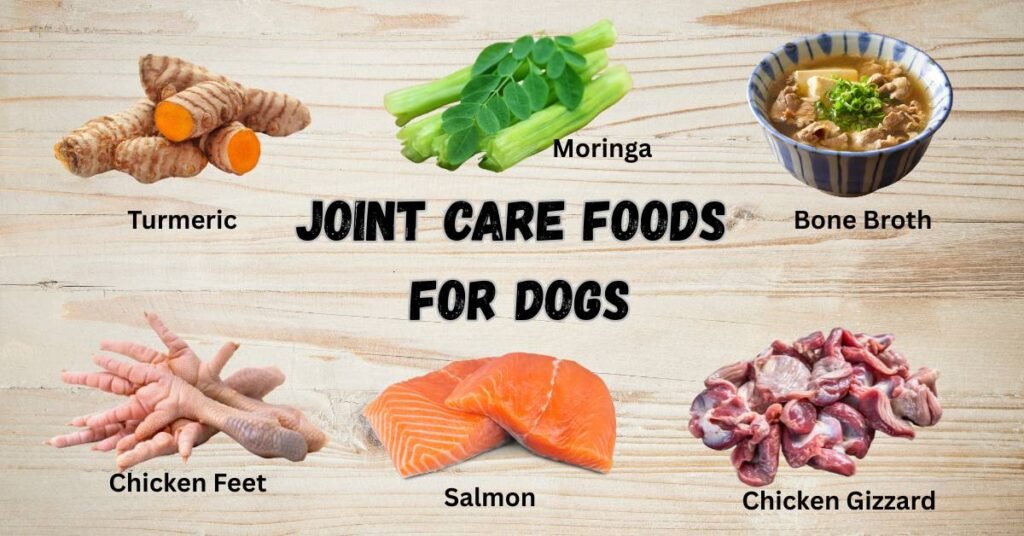
If you’re wondering how to treat joint pain in dogs naturally, adding the right foods can make a real difference. Here’s what I add to their bowls:
Turmeric
Turmeric is a natural anti-inflammatory spice that can help reduce joint pain in dogs. I make a golden paste with ½ teaspoon turmeric, a pinch of pepper (to activate the curcumin in turmeric), and a few drops of coconut oil, and add it to my dog’s homemade meal.
Chicken Feet
These inexpensive treats are naturally rich in glucosamine and chondroitin to support cartilage health in dogs. They serve as great chewy snacks or meal toppers for large breeds. You can either boil it for 2-5 minutes and serve, or dehydrate it in an air fryer.
Chicken Gizzard
Chicken gizzards are packed with protein, glucosamine, chondroitin, and essential minerals for strong muscles and joints. Frequently adding these to your dog’s meal can help maintain joint stability and overall mobility.
Moringa
Moringa is a powerful dog superfood packed with antioxidants and anti-inflammatory properties. It supports joint health and overall well-being, especially in active and senior dogs. Since moringa leaves have a slightly bitter taste, I like to mix a small amount into their homemade chicken meal so it blends right in.
Eggshell Powder
An inexpensive and natural source of calcium that helps to keep your dog’s bones and joints strong. I make it at home and sprinkle a little over their meals to support their joint health and mobility.
Bone Broth
Bone broth is rich in collagen, hyaluronic acid, glucosamine, and minerals that support dog joint health. It’s super easy to prepare at home and makes for a tasty dog treat that helps keep joints well-lubricated. Bone broth is also great for hydration, especially if your dog doesn’t drink enough water.
Oily Fish
Oily fish like sardines, anchovies, mackerel, and salmon are packed with omega-3s that can help reduce inflammation. They support strong joints and a shiny coat. I usually boil them with a pinch of turmeric or air fry them to make a crunchy, healthy dog treat.
Hemp Seed Oil
Hemp seed oil is rich in omega-3 and omega-6 fatty acids that help reduce joint inflammation. It supports healthy mobility, a shiny coat, and overall wellness. I usually sprinkle a bit over their meals for an extra boost of health.
Supplements And Remedies For Joint Problems In Dogs
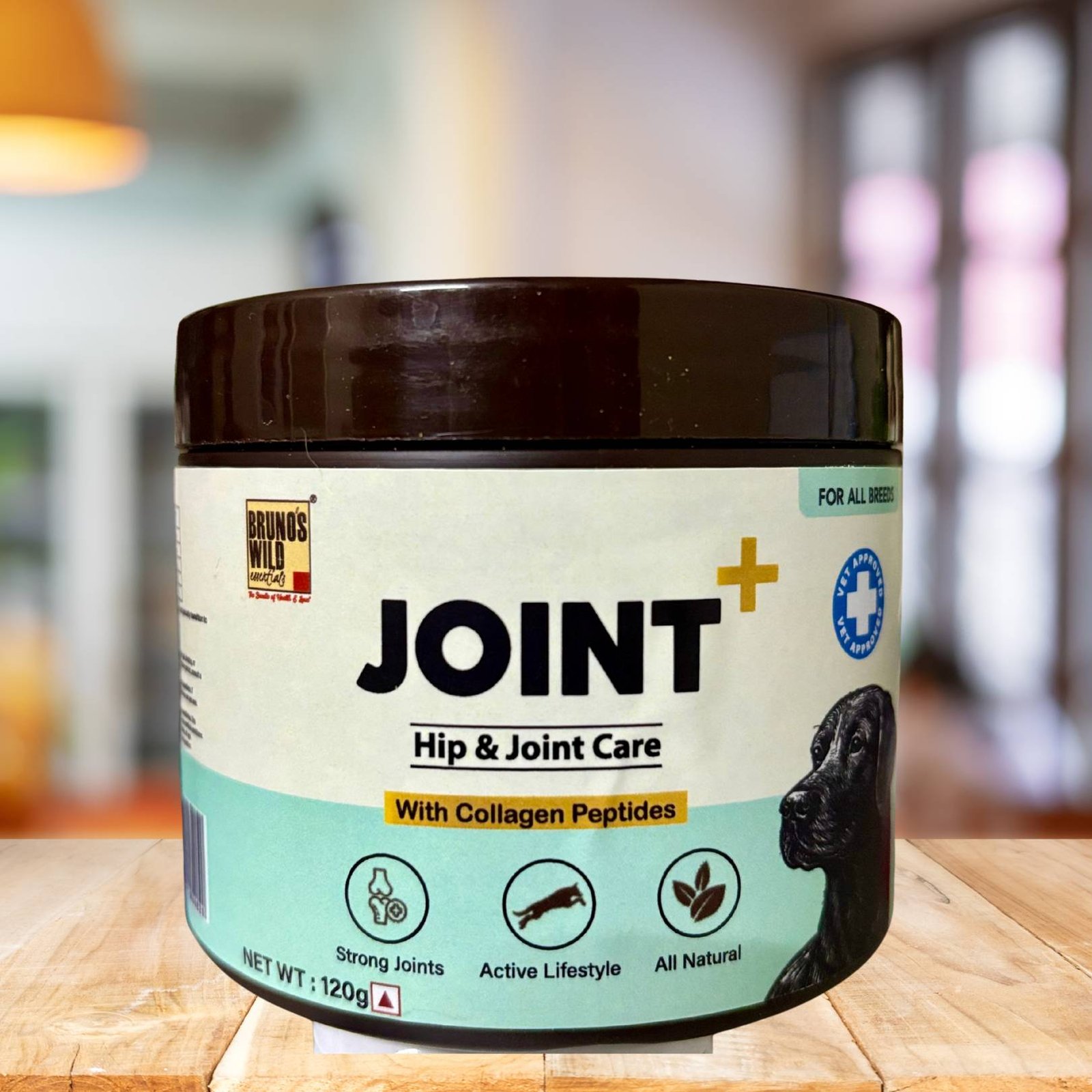
Want to explore the Best Joint Supplements For Dogs In India? Here’s my detailed guide with tried-and-tested options for every age and breed.
What Are Joint Supplements For Dogs? How Do They Work?
Joint supplements for dogs are specially formulated products that help support cartilage, reduce inflammation, and maintain joint function. They usually contain ingredients like glucosamine, chondroitin, MSM, collagen, and omega-3 fatty acids, which work together to keep your dog’s joints healthy and mobile.
At What Age To Start Joint Supplements For Dogs?
For large breeds or dogs genetically prone to joint issues, starting preventive supplementation around 1 to 2 years can help maintain joint health. For senior dogs showing early stiffness or discomfort, regular supplementation can provide relief and support ongoing mobility.
I started my Rottweiler on joint supplements once he turned four, since he began showing mild signs of joint pain.
Key Ingredients To Look For In Your Dog’s Joint Supplement:
| Ingredient | Benefits |
|---|---|
| Glucosamine & Chondroitin | Support cartilage, protect joint structure, and promote smoother movement. |
| MSM & Collagen | Strengthen connective tissues and support flexibility. |
| Omega-3 Fatty Acids | Help reduce inflammation and support healthy joints and a shiny coat. |
| Green-Lipped Mussel / Turmeric | Provide natural anti-inflammatory support and ease stiffness. |
| Eggshell Powder | A natural calcium source that supports strong bones and joint health. |
| Egg Membrane Powder | Rich in collagen, elastin, and glucosamine to support flexibility and reduce joint stiffness. |
| Boswellia Serrata | Natural anti-inflammatory herb that can help reduce joint pain and improve mobility. |
Vet-Recommended Care For Dogs With Joint Diseases
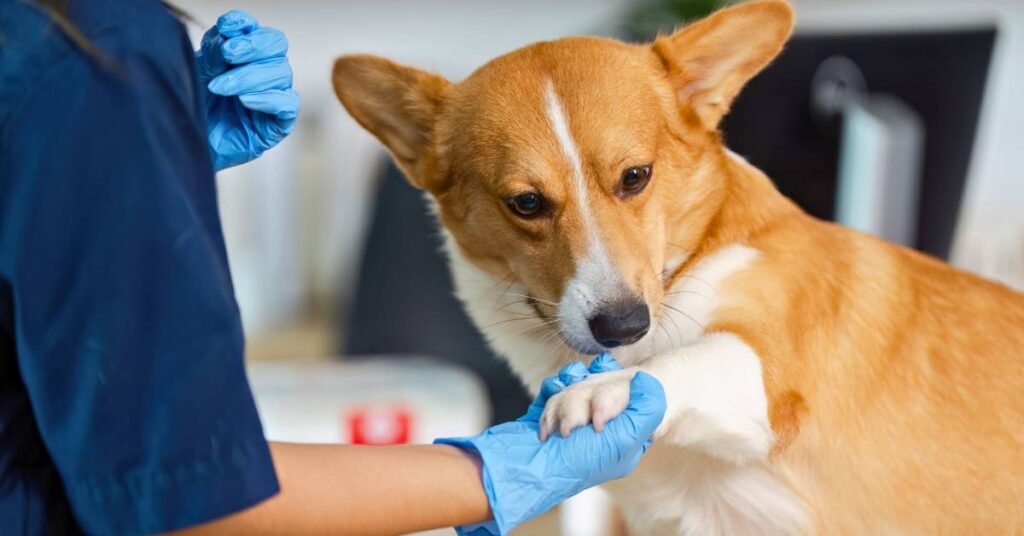
Even with the best diet and supplements, some joint problems in dogs need professional care. Getting your pup checked early can make a big difference in managing pain and keeping their mobility strong.
When to Get Veterinary Help to Fix Joint Pain in Dogs?
It’s best to schedule a vet visit if you notice any of these signs of joint pain in your dog.
- Walking with a limp.
- Stiffness after rest or long naps.
- Reluctance to walk, run, or climb stairs.
- Noticeable pain when touched around the hips or knees.
- Sudden changes in activity levels or mood.
- Whining or yelping during walks or play.
Even mild limping can be a red flag, especially in large or senior dogs. Early diagnosis often means better results and less discomfort for your dog.
What Tests or Treatments Might Be Needed for Dog Joint Pain?
Your vet may recommend the following treatments to check of joint pain in your dog:
- Physical examination to check joint movement and pain response.
- X-rays to detect arthritis, hip dysplasia, or ligament injuries in your dog.
- Blood tests to rule out infections or inflammation.
- Joint supplements or anti-inflammatory medication for pain relief.
- Physiotherapy or hydrotherapy to build strength safely.
- In some cases, surgery if there’s severe damage to the joints.
Regular vet checkups, especially for senior dogs or high-risk breeds, can help catch joint problems early and keep your pup comfortable for years.
FAQs From Dog Parents About Dog Joint Care
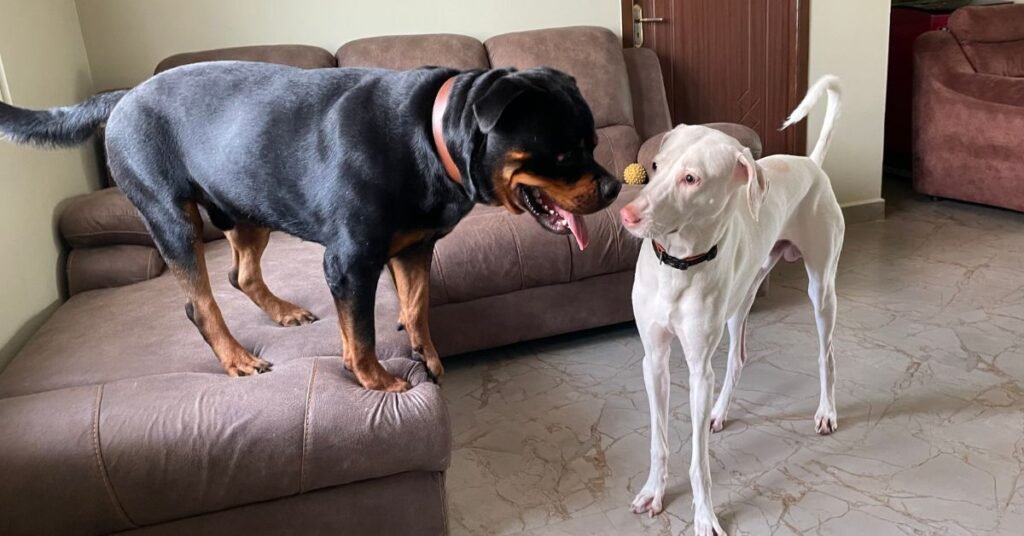
Pawsitive Takeaway
I’ve seen firsthand how small changes can make a huge difference when it comes to caring for your dog’s joint health. Adding anti-inflammatory foods to my Rottweiler’s meals and giving him a good joint supplement for the past six months has worked wonders. A dog who used to whine during play now prances around like a pup!
It’s amazing what consistent care can do to manage and prevent joint pain in dogs. Curious about which joint supplements for dogs actually work? Check out my detailed product guide on the best joint supplements for dogs in India to find the right one for your pup.
Don’t forget to share this article with a pet parent who would find it useful.



